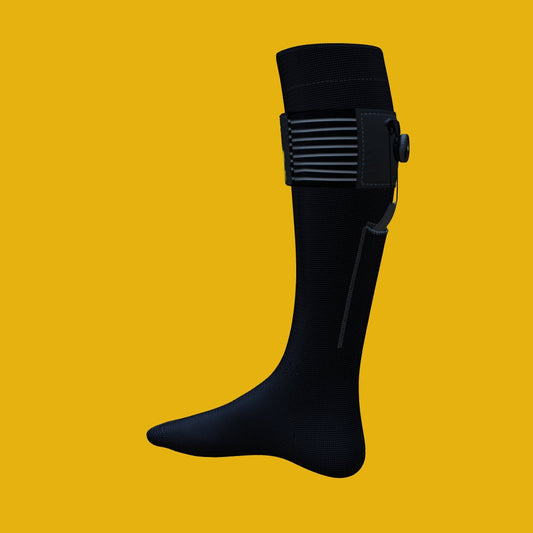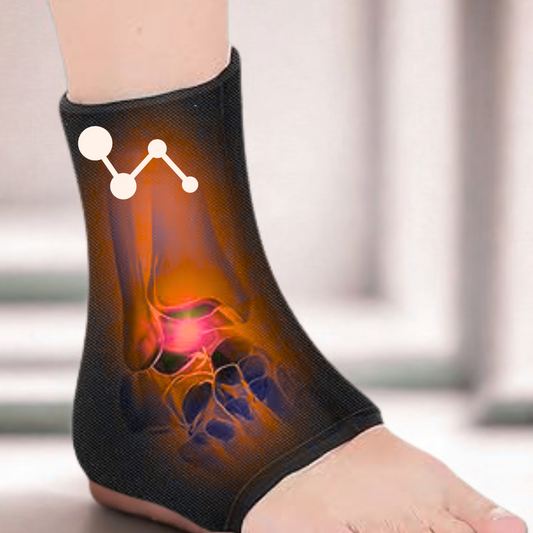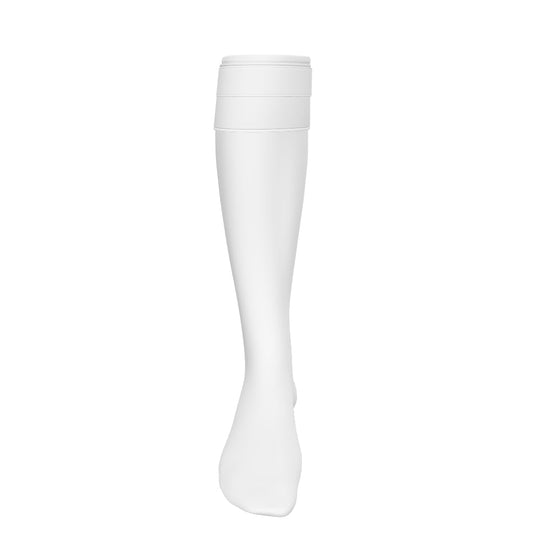
'The Orthopaedic Sleeve'
Step From Pain to Performance
This Brace Assists In Managing:
Sever's Disease
Plantar Fasciitis
Achilles Tendinopathy
Calf Tears
Shin Splints
Anterior Ankle Impingement
'The Orthopaedic Sleeve' is a user-friendly compression style brace, independently tested and validated by a Leading University Biomechanics Lab in Queensland, Australia. Designed to provide effective and targeted workload redistribution and pain relief. Its patented, pathology-specific design reduces strain, supports recovery, and alleviates discomfort from the calf down to the heel and underfoot. Featuring a unique dial tension system inspired by the “Goldilocks Zone” principle, it offers customisable support that perfectly balances comfort and pain relief, tailored to your needs.
Sound like something you need?
Keep reading on!
Patented Design for Targeted Relief
Specifically For Managing:
-

SEVER'S DISEASE
READ MOREA debilitating children's disease that causes heel pain on or around the bone. Often associated with activity and growth spurts
-

ACHILLES PAIN
READ MOREOften referred to as tendonitis or tendinosis. Pain here occurs during or after exercise , tightens with rest and can span to the heel
-

PLANTAR HEEL PAIN
READ MOREPain on the underside of the heel. Presents as sharp in the morning, and after increased bouts of exercise. Can often ache at rest
-

CALF TEAR
READ MOREUsually a sudden traumatic incident that is associated with a pop or pulling/tightening feeling. Can present with bruising, swelling and limping
-

SHIN SPLINTS
READ MOREGradual onset of pain in the shin with increase in exercise. Can be very debilitating and long lasting. Is known as bone stress reaction and can lead to fractures
-

ANKLE IMPINGEMENT
READ MORESharp pain at the front of the ankle that can ache when aggravated. Occurs over time with compressive and repetitive activities like uphill walking
Scientifically Tested
To ensure 'The Orthopaedic Sleeve' had maximum impact for users, we validated our brace within a biomechanics lab of a Top 100 International University to validate our claim that:
"'The Orthopaedic Sleeve' will offload the heel bone by decreasing muscle activity at the calf, lower tension on the Achilles tendon and plantar fascia, reduce heel contact time and reduce ankle compression when applied at appropriate dial tension states.”
The idea being, we want to offload tissue that’s in a pathological state, while maintaining as normal and natural gait mechanics as possible. The testing and analysis demonstrated:
- Up to an 8% decrease in Achilles tendon tension
- Up to 20-48% decrease in EMG muscle signal of the Soleus/Gastrocnemius complex
- Up to a 2-degree decrease in ankle anterior compression angle (~10% of expected range)
- ~5% Reduced heel contact time at mid to end stance of gait (when most tension is on the calcaneal bone)
- No increase in tibialis anterior EMG, decreasing likelihood of converse or reciprocal overloading
- No alteration to natural gait mechanics at the hip, knee, and ankle
- Decrease muscle EMG in complex balance tasks
Impact on Pathophysiology:
Conclusion
'The Orthopaedic Sleeve' brace offers a sophisticated, evidence-based solution for managing Achilles tendinopathy, enthesopathy at the heel, calf tears, Sever’s disease, plantar fasciitis, shin splints, anterior ankle impingement, and related conditions. Its ability to reduce tendon tension, modulate muscle activity, and minimise compressive forces on the ankle—all while preserving natural gait and balance—positions it as a dynamic tool for both acute and chronic phases of recovery. No single measure alone drives healing assistance; rather, the cumulative effect of these targeted, incremental changes fosters an optimal environment for tendon, muscle, and fascial repair over time. By tailoring the brace as required, intervention is customised and disruption to movement mechanics minimised. 'The Orthopaedic Sleeve' strikes a critical balance, promoting healing environments without compromising function. Healthcare practitioners and patients can confidently integrate this brace into a comprehensive treatment plan, as its design aligns with the principles of functional rehabilitation and patient-centered outcomes.
For your own perusal, click the Link Below.
Publicly Reviewed
See what others have said!
The Recovery Bundle
Unlock all-day comfort with The Recovery Bundle! This exclusive package combines our top-selling compression sleeves, braces, and supports at a special discounted price. Crafted for around-the-clock pain relief and mobility support, it’s your key to staying active and comfortable, day or night. Don’t miss out—grab this unbeatable deal now and feel the OrthoSleeve difference!
Have a Closer Look!
Click here to spin, zoom, and explore our game-changing brace in stunning 3D – see the future of support in action!
What Does This Brace Actually Do?
Understand It's Impact for You!
“The Goldilocks Zone” Principle
- "Just Right" Tension Adjustments as You Need It
- Relief based on Your "Right Now" Requirement
- Build the Optimal Environment for Your Injury to Recover
Promote The Right Environment
- Control Your Loading
- Decrease Flare Ups & Aggravating Events
- Control Muscle Activity Levels to Promote Healing
- Decrease Tendon and Ankle Angle Compression
- Minimise Joint Loading
- Reduce Soleus and Periosteal Bone Loading
Normalising Movement Patterns
- Reduce Limping and Reset Walking Patterns
- Decrease Pressure for Long Standing Periods
- Shield Muscles and Tendons Through Healing Periods
- Get Back to Exercise Intervention Sooner
Facilitate Progression
- Mimic Natural Biomechanics of Muscles, Tendons, Ankle and Plantar Fascia
- Facilitate Progression of Natural Walking and Running Loads
- Initiate Earlier Exercise Intervention or Assist Plateau Progression
- Build Endurance Capacity with Relative Work Redistribution
Patented Exoskeleton Design
- Ability for Customised and Adjustable Support via Twist to Tension Dial Design
- Mixed Webbing Configuration to Mimic Real Heel Mechanics
- Compression Support for Swelling Management and Environmental Healing Factor
Healthcare Practitioners
Clinical Application Summary
'The Orthopaedic Sleeve', developed by The Orthopaedic Sleeve Society (TOSS), is a biomechanically advanced, adjustable brace designed to optimise recovery for heel-related and ankle pathologies, including calf tears, Achilles tendinopathy/enthesopathy, Sever’s disease, plantar fasciitis, and anterior ankle impingement. By modulating electromyographic (EMG) signals, reducing tendon and fascial tension, redistributing workload, and limiting ankle dorsiflexion, it aligns with pathophysiological healing stages to accelerate recovery, normalise gait, and minimise complications such as retrocalcaneal bursitis, Kager’s fat pad irritation, or fibrosis. Below is a concise guide for healthcare practitioners to effectively integrate 'The Severs Sleeve' into evidence-based rehabilitation protocols.
Key Benefits and Mechanisms
1. Pathology-Specific Support
- 'The Orthopaedic Sleeve' targets specific structures (plantar fascia, Achilles tendon, calcaneal apophysis, anterior tibiotalar joint) to reduce tensile and compressive stress, protecting injured tissues and promoting healing without restricting uninjured areas.
- Clinical application: In plantar fasciitis or Sever's disease, 'The Orthopaedic Sleeve' offloads the enthesis of the Achilles and plantar fascia on the calcaneus; in anterior ankle impingement, 'The Severs Sleeve' minimises synovium/capsule compression.
2. Biomimetic Design:
- 'The Orthopaedic Sleeve' mimics natural heel and ankle biomechanics, reducing compensatory pain patterns (e.g., limping, forefoot striking) that strain secondary joints (e.g., metatarsophalangeal, knee, hip joints).
- Supports symmetrical gait, enhancing functional recovery across conditions like Sever’s disease or Achilles tendinopathy.
3. Adjustable Tension for Healing Phases:
- 'The Severs Sleeve' features a patented tension system with high (maximum offloading), moderate, and low (progressive loading) settings to align with inflammatory, proliferative/dysrepair, and remodelling/chronic phases.
- Acute Injury Phase: High dial tension minimises the EMG activity and muscle stress, reducing edema and inflammation. Such as during the first four weeks of plantar fasciitis and the first six weeks for Sever’s disease.
- Semi-Acute Phase: Moderate tension introduces controlled loading to stimulate collagen alignment and tissue repair. Such as weeks four to twelve of Achilles dysrepair.
- Return-to-Activity Phase: Low tension encourages functional adaptation and strength. Such as weeks 12–24+ for degenerative tendinopathy.
4. Stress Shielding for Tissue Protection:
- 'The Severs Sleeve' redistributes workload to the brace as a synergistic muscle and connective tissue, supporting secondary injury prevention and early ambulation without overloading damaged structures.
- The brace reduces: Achilles tendon tension, muscle stretch during activation with tears, plantar fascia eccentric straining in fasciitis, anterior joint compression in impingement, neovascularisation, fibrosis and microtears.
5. Reduction of Kinesiophobia:
- 'The Severs Sleeve' provides stable, pain-reducing support through lightweight, breathable materials and an ergonomic, adjustable fit, boosting patient confidence in weight-bearing and movement.
- The brace encourages adherence to rehabilitation by alleviating fear of reinjury, critical for athletes or active children with Sever’s disease.
6. Restoration of Normal Movement:
- 'The Severs Sleeve' limits dorsiflexion to reduce retrocalcaneal compression (e.g., bursitis, Kager’s fat pad irritation) and anterior joint stress, restoring stride length and cadence.
- Clinical example: In Achilles enthesopathy, dorsiflexion control minimises retrocalcaneal bursal inflammation, enabling influence on retrocalcaneal structures.
7. Patient Autonomy and Long-Term Outcomes:
- Easy-to-adjust tension settings empower patients to tailor support to their recovery stage, fostering independence and compliance.
- Supports long-term function by preventing recurrence through education on load management, footwear, and maintenance exercises.
Practical Implementation
- Initial Use: Start with 1–2 hours daily, increasing by 1 hour/day until fully tolerated, ensuring comfort and skin integrity.
- Complementary Interventions: Pair with heel lifts (5–10 mm) for enthesopathy or Sever’s disease, custom orthotics for plantar fasciitis, or footwear adjustments for anterior impingement to enhance biomechanical support.
- Exercise Integration: Combine with condition-specific exercises (e.g., isometric heel raises for Achilles tendinopathy, intrinsic foot strengthening for plantar fasciitis, eccentric loading for calf tears) to align with brace tension settings.
- Monitoring: Use validated outcome measures (e.g., VISA-A for Achilles, Foot Function Index for plantar fasciitis, FAOS for ankle impingement) and imaging (ultrasound, MRI) to assess healing and adjust brace settings.
- Contraindications: Avoid low-tension settings or excessive dorsiflexion in early phases to prevent tissue irritation. Monitor for complications (e.g., compartment syndrome in calf tears, microfractures in Sever’s disease).
Clinical Considerations
- Individualisation: Tailor tension and dorsiflexion limits based on pathology stage, patient factors (e.g., age, activity level, comorbidities), and biomechanics (e.g., overpronation, tight calf muscles).
- Interdisciplinary Collaboration: Coordinate with physical therapists, podiatrists, and orthopedists for complex cases, such as degenerative tendinopathy or chronic impingement with osteophytes.
- Patient Education: Instruct on brace use, load management (<10% weekly activity increase), and maintenance exercises to sustain recovery and prevent recurrence.
Conclusion
'The Severs Sleeve' is a versatile, patient-centred tool that bridges pathophysiology and biomechanics to optimise recovery across heel and ankle pathologies. By providing adjustable, pathology-specific support, the brace supports a healing environment, normalises gait mechanics, and empowers patients to transition from pain to performance. Healthcare practitioners can confidently integrate 'The Severs Sleeve' into rehabilitation protocols to achieve faster, more sustainable outcomes.
From Pain to Performance
The Orthopaedic Sleeve Society (TOSS)
Daily Clinical Expertise into New Age Bracing
The Orthopaedic Sleeve Society was founded when our Directors recognised that outside of the best clinical taping techniques they'd developed for heel related pain, there were few bracing options that could replicate pain relief reliably for their patients. As a result, they took 30 years of Physiotherapy and Podiatry training and experience, combined it with the best international industrial designers and manufacturers.... and 'The Orthopaedic Sleeve' was Born.


















